- Ancient greek hairstyles
- Characteristic features of hairstyles
- Ancient Greeks hairstyles today
- Renaissance hairstyles
- Period characteristics
- Modern options
- Baroque hairstyles for women
- Characteristic features of styling
- Modern options
- 19th century hairstyles
- Characteristics of the era
- Medieval hairstyles
- Characteristic features of hairstyles of this time
- Ancient roman hairstyles
- Characteristic features of ancient Roman hairstyles
- 18th century hairstyles
- Characteristic features of styling
- Crazy 17th century hairstyles
- Characteristic features of styling
- Rococo hairstyles
- Characteristic features of hairstyles
- Hairstyles of ancient egypt
- Characteristic features of hairstyles
- Empire style hairstyles
- Characteristic features of hairstyles
- The Great Gatsby Hairstyles
- Style characteristic
- Hairstyles of Ancient Russia
- Characteristic features of hairstyles
- Conclusion
Ancient greek hairstyles
Characteristic features of hairstyles
In addition to clothes, the hairstyle was gradually changing. Blonde hair was considered the standard of beauty, so dyeing and lightening curls was developed and in great demand.
Initially, ground rice and flour were used to achieve snow-white curls.

The Greek women did not wear headdresses at all, so they tried to decorate their heads with a harmonious hairstyle, flowers, jewelry, wreaths and other accessories. The first hairstyles were simple - the curls were twisted and tightly laid on the back of the head, covering them with a bag.

The Greek knot is considered the classic female styling of Ancient Greece.
A frame was used to make a cone-shaped beam. Over time, the location of the styling and the option of curling the curls changed. For example, the Greek torch-shaped knot was called "lampadion", and the pouch at the neck was called "korimbos".

- Apollo bow - this styling was used by both men and women. In ancient Greece, it was customary to hide part of the forehead with curls.

A bow on the crown, framed by curls, in the 5th century BC. introduced to Aspasia (the second wife of Pericles). The hair was curled in large rolls and laid along the head (from the forehead to the back of the head), at the back of the head they were gathered in a bow.

The next stage of Greek hairstyles is curled long hair, decorated with a hoop. Long-term rinsing with herbs was used to give the curls a golden hue.
In later periods of the history of Ancient Greece, loose hair was allowed to be worn only by priestesses.

End IV - early I century BC marked the emergence of wigs. Only rich Greeks could buy them, due to the high cost of headgear.
By the way! For slaves, the choice of hairstyles was limited, their hair was cut short (to the middle of the neck), and the forehead was covered with bangs.
Everyone can distinguish a Greek hairstyle from any other style. Lightness and refinement of styling, harmony and natural charm, tenderness and sensuality of the created image are the main distinguishing features.
To create a hairstyle, use a headband, a bandage, a bow. Hair is often curled into large curls and gathered.
Ancient Greeks hairstyles today
Greek hairstyles are often used by modern beauties. Such styling is appropriate for every day and for the planned important event. They look restrained and elegant, they are suitable even for business women, they are not age-demanding.
Greek knot, Greek braid, hairstyles with or without rims are very popular these days.

There are no restrictions in the choice of styling according to the type of face and the external data of the girl, but owners of a round, pear-shaped face should be extremely careful. Many Greek models suggest the creation of additional volume in the neck area, which will only add volume to the rounded cheeks.

Hair length can be different, even girls with short hair can recreate the image of a Greek goddess by decorating their hair with a golden headband or headband. It is preferable that the hair is below shoulder level. The longer the curls, the more variations the master will be able to perform.

To make the styling look graceful and feminine, the ancient Greeks additionally curled curls, giving them volume. For modern girls, stylists also recommend pre-winding curls on large curlers, a curling iron, if nature has not endowed you with thick hair.

If the proposed hairstyles in Ancient Greece were also performed by men, today representatives of the strong half of humanity have completely abandoned them.
Renaissance hairstyles
Period characteristics
If the Middle Ages is a period of religious fanaticism, then the Renaissance is a completely new stage in the history of mankind, when humanism and anthropocentrism become key concepts. Faith in reason, wisdom, intellect, admiration for creativity come to the fore.
In search of landmarks, interest in the ancient heritage reappears, as if it receives a second life, revives. Hence the name of a whole era in the history of culture and art.

It was the Renaissance period that included paintings by Leonardo da Vinci, Raphael, Michelangelo, Titian, Botticelli, the literary creations of Dante, Petrarch, Shakespeare, Cervantes. At this time, science began to develop actively. People are more and more interested in how the world around them works. The works of Galileo, Copernicus, Montaigne, Machiavelli, and others are dedicated to this.
By the way. First of all, the Renaissance came to Italy (14th century), and from there spread to other European countries (15-16th centuries).
In comparison with the Middle Ages, fashion has also changed significantly. The tone of the whole society was set by representatives of the royal family. With their submission, new clothes and hairstyles became popular. For example, the French queen Catherine de Medici introduced women's pantaloons into fashion.

Berets were in demand during the Renaissance. Men cut their hair short, and women let out from under the headdress curled locks decorated with beads or ribbons. If the gentleman wore long hair, he also curled it up.
Also, men did not deny themselves the pleasure of browning their faces or perfume.

Unlike the Middle Ages, Renaissance outfits are characterized by a tendency towards horizontal lines and silhouettes: an emphasis on the shoulders, a wide bottom. Men's shoes are no longer pointed, but soft, without heels, with a blunt toe.
Another important feature of the costumes: the abundance of cuts through which the underwear was visible. Along the edge, these holes were trimmed with piping and threads.

The style and details of the Renaissance costume varied from country to country:
- In italy women and men wore shimaru - a kind of cloak-mantle. Ladies put on a cott dress under it, which consisted of a corset or bodice, as well as a skirt. The outfits were sewn from expensive fabrics: velvet, brocade, etc. The most fashionable shades were emerald, green, wine. Italian clothing of that time reflects the signs of antiquity: simplicity, soft smoothness, the presence of free folds, etc.

- Spaniards dressed in dresses resembling 2 triangles in shape, the tops of which converge at the waist. This was achieved through the use of pads, frames. The image was complemented by a high collar and unusual hats. The men wore tight frame suits stuffed with sawdust, cotton wool, etc.
One of the main details is the voluminous cutter collar. Since the 15th century, dark colors have predominated in Spanish Renaissance clothing.

- French outfits were simultaneously influenced by Italy and Spain. White shirts came into fashion here, later - knitted stockings. Light colors become favorites. Pink, blue, green are worn by both men and women.The dress of the Frenchwoman had a narrow, rigid bodice, a deep neckline, a stiff lace collar, and puffy puff sleeves.

- Outfits in Germany for a long time they were influenced by medieval tendencies. They had proportions stretched vertically: high hats, long-nosed shoes. Later, decorative cuts appeared on German Renaissance costumes.
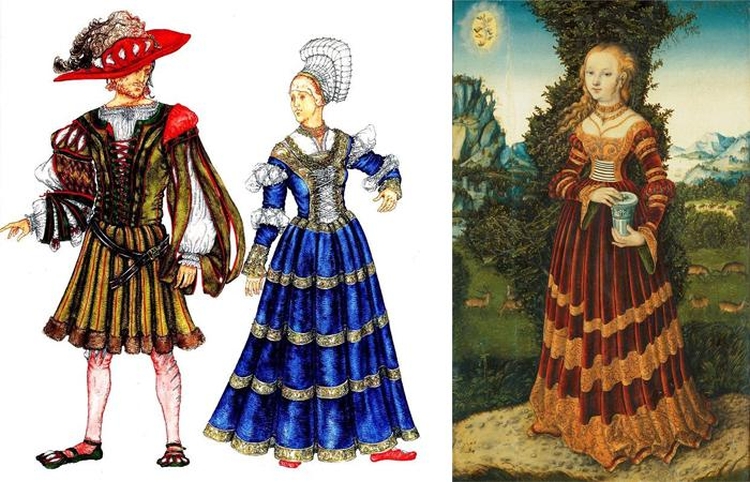
- English clothing aristocrats were luxurious: velvet, furs, oriental fabrics, bright colors. The outfits of the court nobility were decorated with embroidery, precious stones, and lace. Representatives of the rest of the estates wore modest, sometimes even gloomy vestments.
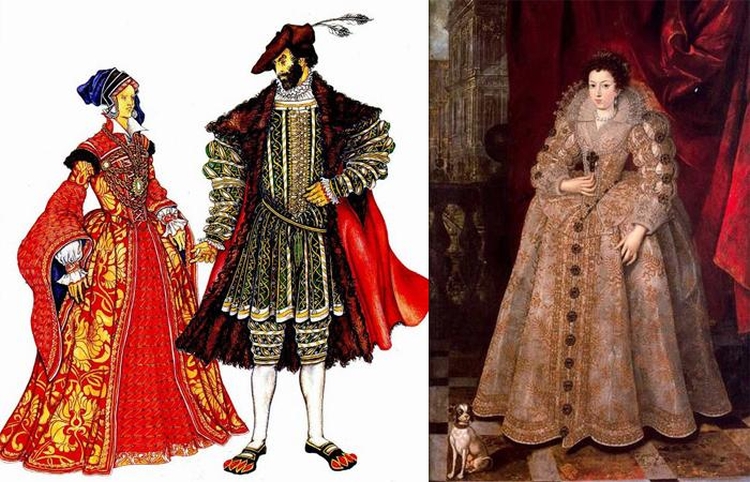
By the way. In addition to new outfits and hairstyles, the Renaissance saw a fashion for gloves, fans, and half masks.
Modern options
For a romantic or festive evening, you can opt for a curl or braided hairstyle. For example, do a side french braid from forehead to nape, and style the rest of your hair in a low bun.
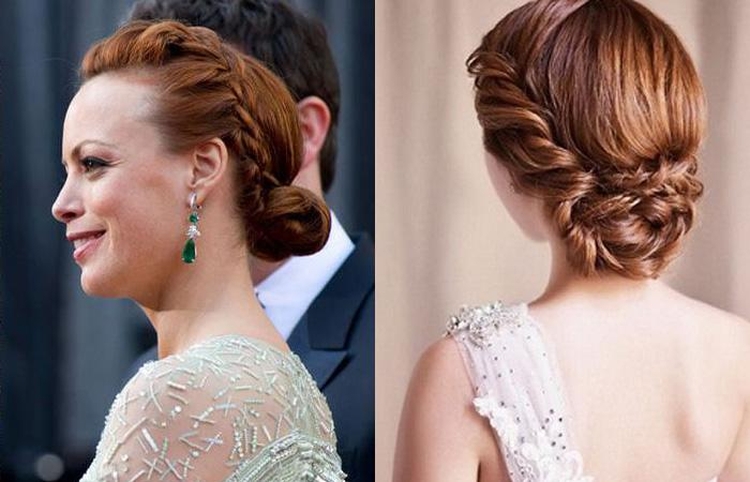
Or, make a high bun by complementing it with several pigtails of different thicknesses. Lay the braid around the head at random, complementing the hairstyle with a decorative cord or ribbons.

You can make three vertical beams in the spirit of the Renaissance. Separate 2 strands on both sides of the forehead. Braid this hair into 2 braids. Connect them at the top of the head, lay them in a bun. Repeat the same steps twice.
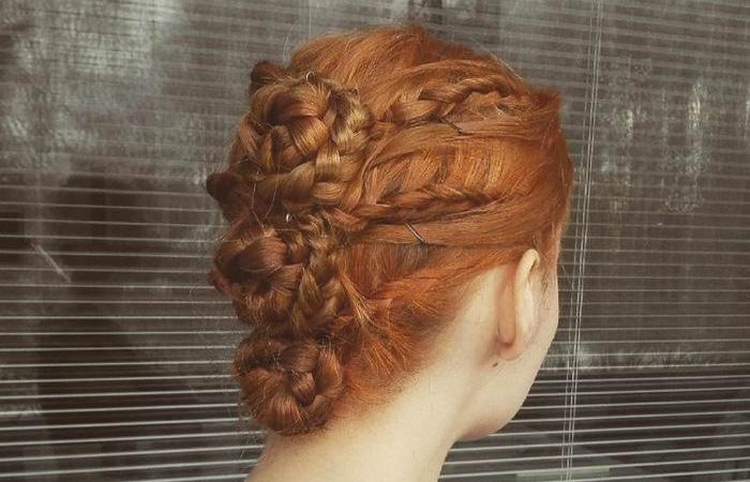
More sophisticated Renaissance hairstyles combine both curly hair and a variety of weaves. You can twist the curls with a curler or curling iron, after separating part of the strands for braids. Or to form a weave from wavy, already curled hair.
Such hairstyles look especially luxurious in combination with rich decor: braid, decorative laces and hairpins, beads, etc.
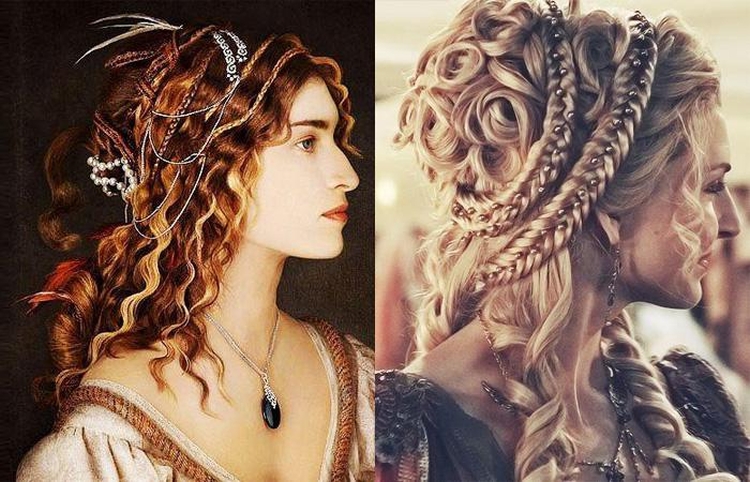
Baroque hairstyles for women
Characteristic features of styling
Everyone watched the presentable look of their hair: both men and women. Often, both wore voluminous, tall, heavily powdered wigs. The head itched in them, so the court ladies and gentlemen had special sticks for this case, with which it was possible to eliminate the itching in the hair.
Sometimes midges and even small rodents appeared in lush wigs, which probably considered fashionable volumetric attributes to be cozy minks and nests.
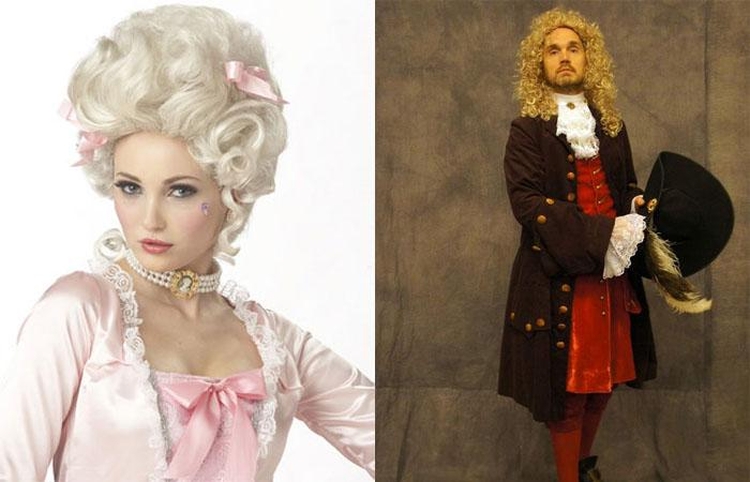
Initially, men's baroque fashion for haircuts was associated ... with collars. At first, short hair was in favor, which did not interfere with wearing a collar-cutter - a wide, dense, strongly starched white "ring" tightly fitting to the neck. In the 20-30s of the 17th century, men began to grow and curl their hair.
The hairstyles were complemented by thin braids and bangs. In clothes, a turn-down collar has come into fashion.
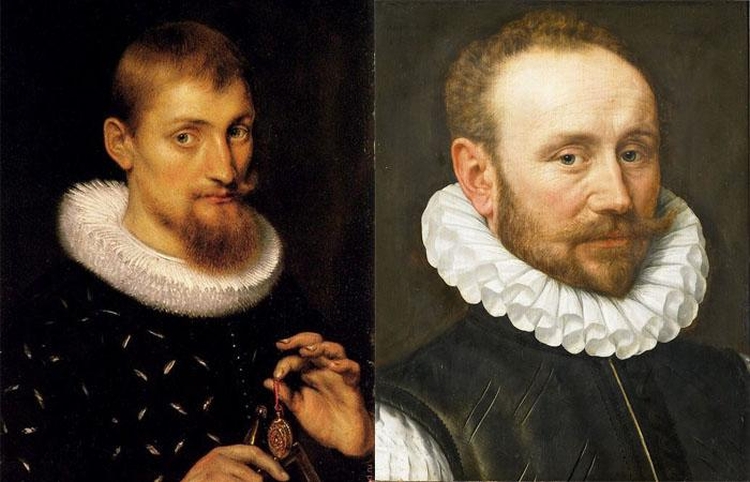
Styled hair was decorated with bows and jewelry. Later, during the reign of Louis XIV, the trend continued, but it was during this period that natural curls were replaced by artificial ones. History claims that the "sun king" introduced the fashion to wigs, because he himself had become bald by that time. Lushly curled fake hair was attached with a cap covered with a fine mesh.
In addition, in the Baroque era, men smoothly shaved their faces, complementing their appearance with a "chevalier" mustache (narrow stripes with curled ends), a wedge-shaped beard.

By the way. Wigs made from blond hair were especially prized. For a period they were the privilege of members of the royal family. For the same reason, artificial hair of other shades was abundantly powdered - lightened. By the 70s of the 17th century, blond wigs were superseded by auburn wigs.
Women also wore false hair, but more often it was separate strands that added volume and length to the hairstyle. Imitating men's fashion, the ladies curled lush curls that flowed down the back and shoulders. During the Baroque period, there were several main female styles, which replaced each other throughout the era. The main ones are:
- "Al-Anfan" (meaning "childish") - curled hair was tied with a ribbon around the head;
- "Garsett" - hairstyle with curls on the forehead and on the temples;
- "Fireworks" - smoothly laid front strands passed into a volumetric bun at the back, and curls descended on the sides in the form of a corkscrew. The hairstyle was brought into fashion by the wife of Louis XIII - Anne of Austria, Queen of France and mother of Louis XIV;
- "Maria Mancini" - that was the name of one of the favorites of the "sun king", after which the women began to curl their hair in small curls and style them on both sides of the face in the form of two hemispheres;
- "Yurlyu-berlyu" - a hairstyle similar to styling a la Maria Mancini: the curls were laid in symmetrical rows along a straight parting and decorated with ribbons. A couple of curls were left on the shoulders;
- "Sevigne" - bunches were formed from curled hair around the head.
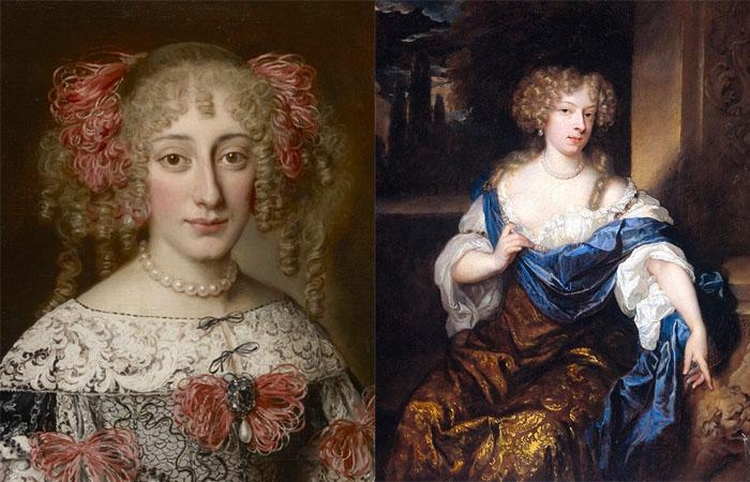
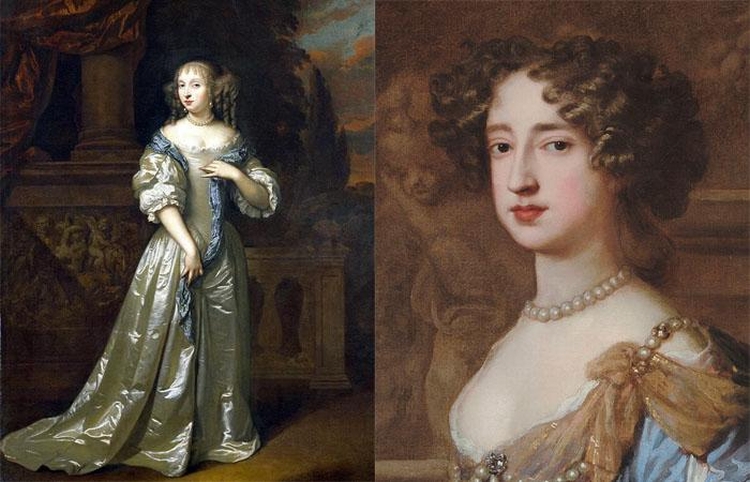
Ladies often did hairstyles that rose several tens of centimeters above the crown (wire frames were used). Such piles resembled in their splendor and pretentiousness men's baroque wigs.
It is believed that the famous high hairstyles began with the Fontange hairstyle. She has an interesting story.

Maria-Angelica de Fontanges was the favorite of Louis XIV. One day during a royal hunt, her hair was disheveled. The woman was smart and gathered her hair in a high bun, tied with a stocking garter with jewelry (some sources claim that it was lace from the sleeve).
The king appreciated the resourcefulness of his beloved, and since then many court ladies began to do high hairstyles.
By the way. There was also such a headdress - "fountain", which was a cap.
In the final years of the reign of Louis XIV, women's hairstyles became more modest. The "Knot of humility" was especially popular. Smoothly combed hair was gathered in a low bun. The trend was set by the Marquise de Maintenon - the last love of the "sun king".
In the 18th century, the Baroque style became less and less popular. It is being replaced by another direction - "rococo", which is considered a continuation or even the highest stage in the development of baroque aesthetics.
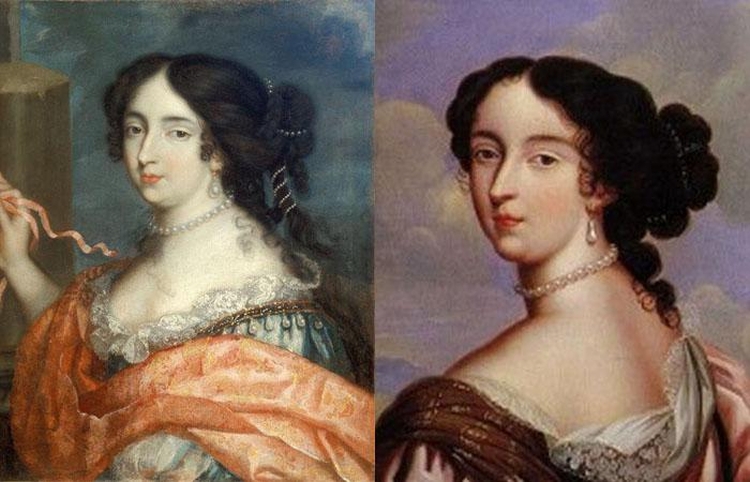
By the way. High hairstyles are one of the features of both styles. Just look at the portraits of Queen Marie Antoinette. A personal hairdresser even came up with a folding mechanism for her, since high-styled hair caused inconvenience during carriage rides, walks under low arches, etc.
Modern options
Not a direct repetition, but the stylization of baroque hairstyles is a compromise solution for women who want to diversify their image with lush, high-styled curls, but at the same time refuse to look old-fashioned.
To avoid this, you should not load your hairstyle with all the elements characteristic of the Baroque at once: an open forehead, a pile on the top of the head, vertical curls, including on the sides, an abundance of decor.
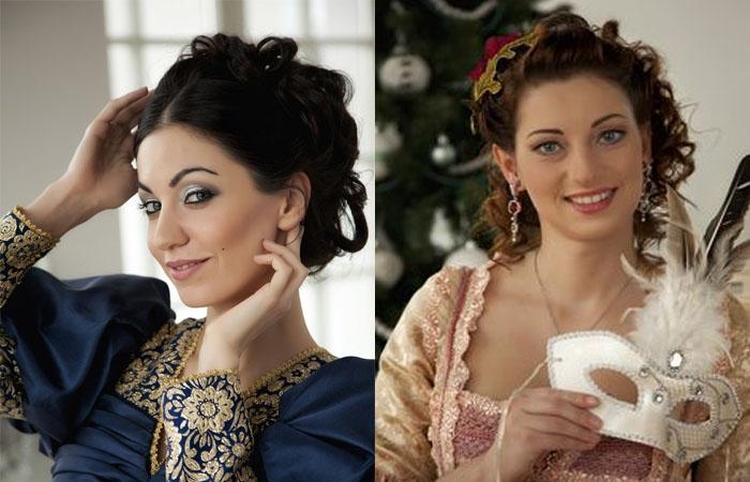
Discreet options that may be quite appropriate are Babette or French bunch, as well as their counterparts. You can complement the high styling not with side strands, but with a small pigtail.
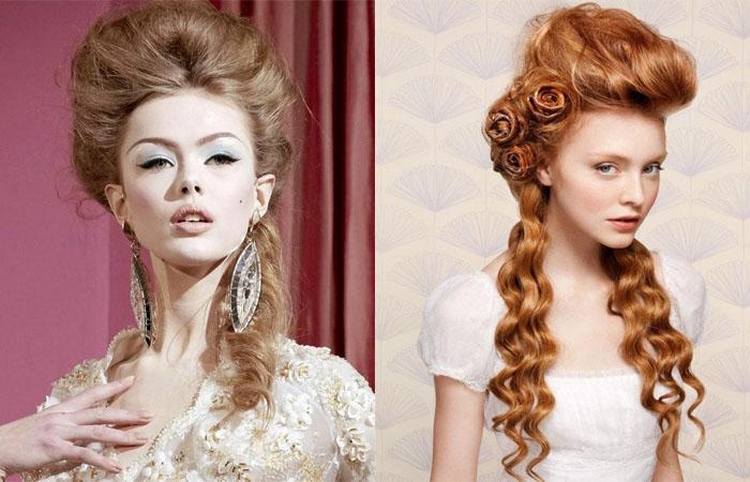
19th century hairstyles
Characteristics of the era
19th century fashion trends changed every decade. With the advent of the Great French Revolution, a protest against the grotesque, noble rococo arises in society; luxury is replaced by the simplicity and brevity of antiquity.
There are hairstyles a la Greek, "Psyche Knot", as well as "Victim's Hairstyle" - short-cropped curled locks, the image imitates prisoners sentenced to death.

Laconic forms, striving for naturalness lasted about 20 years. Antiquity also influenced the girls' wardrobe. High-waisted dresses are in fashion, clothes were sewn from different fabrics, including brocade and velvet. Each occasion had its own outfit, dresses for walking were closed, made of thick cloth.
Ballroom dresses were created from light, airy fabrics, distinguished by a fitted silhouette, an open neckline.
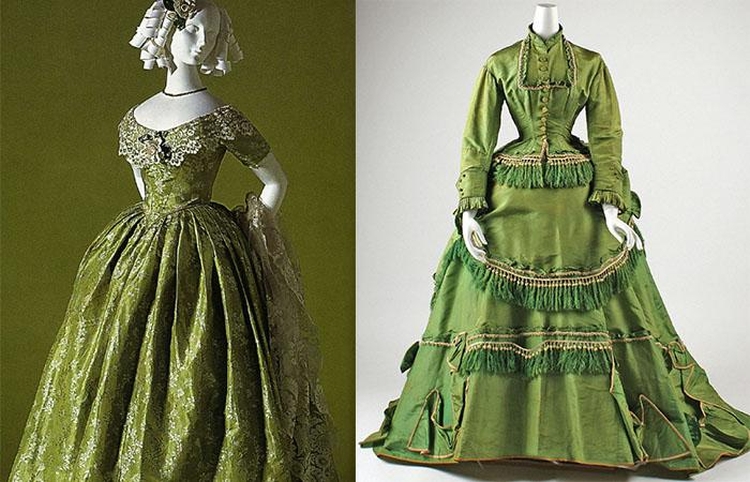
Gradually, there is a transition from simple to new, more complex forms. A hairstyle appears with curled curls at the temples, a neat basket of braids laid at the back of the head. It was a period of transition from the Empire to the Victorian style, young ladies tried to imitate antiquity, while turning to the complex designs of Rococo.

The turning point was the coronation of Queen Victoria, who opted for a fairly simple styling with two braids. With the onset of the stage of romanticism, which falls on the middle of the 19th century, the dominance of bunches and textured curls begins. The "home angel", a timid, pretty girl, whose main virtue was meekness, becomes the ideal of beauty.
The era of romanticism requires new forms, the waistline is gradually lowered, voluminous sleeves become graceful and neat. Curvy skirts are replaced by crinolines created from horsehair. The voluminous bottom is emphasized by a thin waist, the V-neckline is becoming popular.

By the middle of the 19th century, crinolines become immensely lush. The effect is achieved through the use of a whalebone frame. Skirts taper towards the waistline, widening downward, take on a flatter shape in the front, bulky in the back.
In hairstyles, hairpieces are becoming relevant, at different periods of the era they were fastened in the back of the head, crown of the head and even bangs. The first methods of perm appear.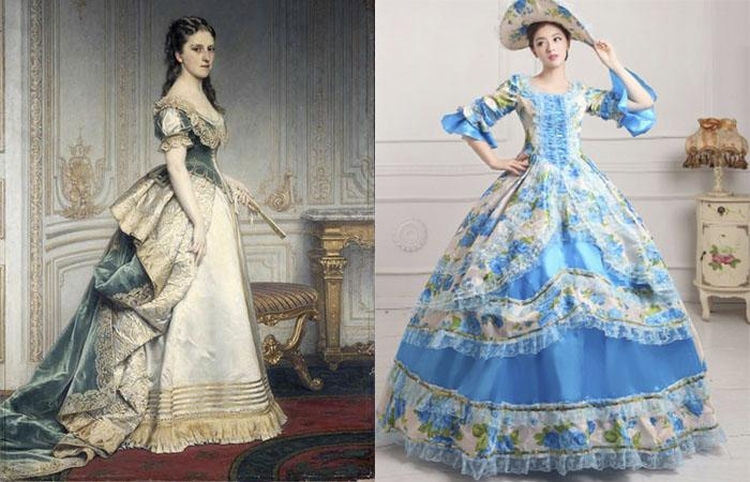
In the styling of 1870-1880, there are intricate forms, they wore high hairstyles. Volume was given with the help of overhead curls; straight and curled bangs were popular. Until the end of the 19th century, hairstyles take on simpler forms, become smooth, the hair is parted in a straight part. At the back, a mass of hair is supported by gold nets, which served as fashion accessories, often adorned with precious stones.
In the last years of the Victorian era, the "Pompadour" hairstyle appears. The curls were lifted up, several strands fell off the face, there were many variations of this styling.

Blond hair gives way to dark brown strands, a similar shift in the ideals of beauty is observed under the influence of the personality cult of Queen Victoria. Pale porcelain skin was prized, tan and blush were signs of low class.

By the way! In order not to use tons of bleaching powder, the young ladies hid their skin under umbrellas, gloves, hats, or even did not go outside at all in clear, sunny weather.
Particular importance was attached to the gaze, in order to achieve the desired languor, the eyes were buried with poisonous extracts, which gradually killed fashionistas. The development of the industry also affected the variety of decorative cosmetics, there were formulations for the makeup of the eyelids and lips. When applying coloring compositions, it was necessary to achieve a natural effect. The abundant use of cosmetics was discouraged in high society.
Men's fashion was less volatile, consistent throughout the century. The wardrobe consisted of a tailcoat sewn at the waist, a vest, a tie, long narrow trousers, and a top hat.
Dark colors prevailed, only details and accessories were bright. The freer forms of the suit have become thanks to the processes of industrialization, as well as the popularization of games and cycling. The Victorian era is considered the heyday of dandyism. This is the name given to young people who dictate fashion trends and adhere to a certain code.
The main idea was graceful modesty, a lot of time was devoted to the selection of a suit, it was necessary to avoid vulgarity and arrogance.
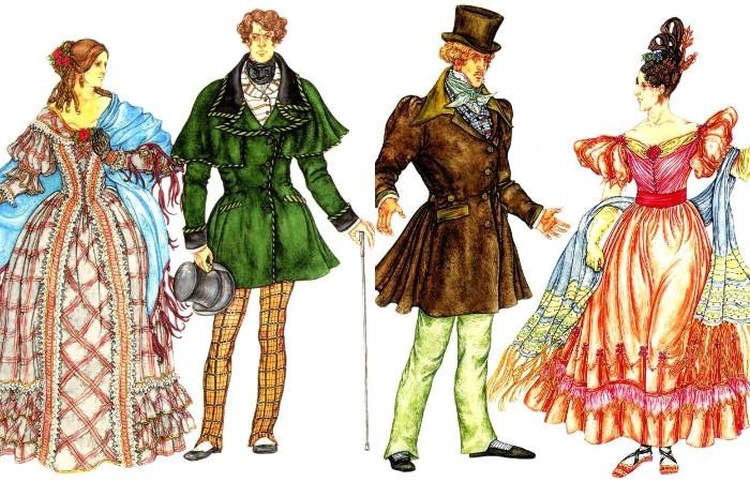
Medieval hairstyles
Characteristic features of hairstyles of this time
During the Middle Ages, women diligently hid their hair behind headdresses. The church dictated simplicity, modesty; men's hairstyles were also not very diverse. The main focus was on the accessories that decorate the hair.
They used crowns, scarves, gold nets, bonnets. For centuries, men wore the "Peisan" haircut, the distinctive features of the estates were only headdresses.
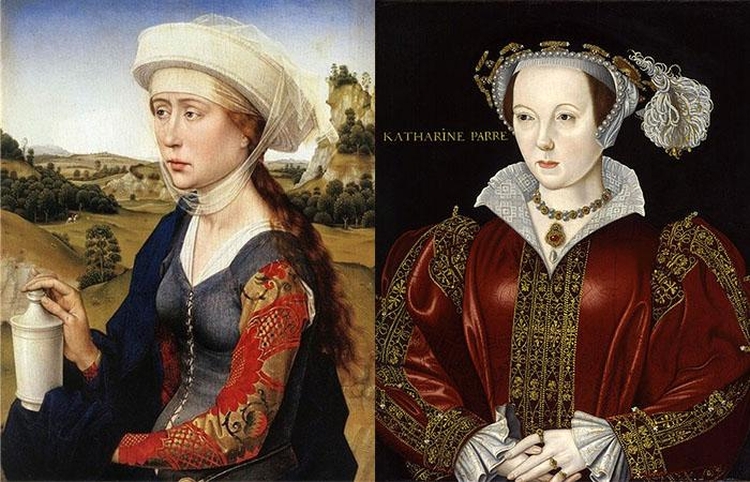
Characteristic features of the Middle Ages:
- "Knightly" braids were long weaves the width of a palm, for which fabric cuts were used;
- lateral snail braids were created from two parallel spikelets laid at the temples;
- men wore short haircuts with bangs, a beard was an obligatory element of the image;
- simple hairstyles took on sophisticated forms through various headdresses and ornaments.
Ancient roman hairstyles
Characteristic features of ancient Roman hairstyles
Ancient Roman styles were transformed along with the development of the empire. During the period of the Republic, haircuts, hairstyles were distinguished by their brevity and simplicity. Basically, the hair was tucked into neat rolls at the back of the head, crown. The men wore short hair.
With the flourishing of the Empire and the replenishment of the treasury, the time of luxury and decoration came. Both men and women paid special attention to their appearance.

Specific traits:
- curled curls of different shapes and diameters;
- there was symmetry in the form of a straight parting, neatly arranged curls on the sides, on the back of the head;
- high frame piling opened the line of the neck of the shoulders;
- men wore short haircuts of straight or curled hair.
18th century hairstyles
Characteristic features of styling
Men's wigs don't go out of style. At the beginning of the century, representatives of the sterner sex without exception wear artificial curls. Only the volume of the wig, the nature of the styling of the strands, changes. The length is shortened, the uniform curly structure gradually disappears.

Since the 30s. the hair is combed back smoothly, slightly lifting the parietal part up. 2-3 horizontal rows of curls are laid on the temples. From the back, the strands were removed in a tail or pigtail. The element reached the shoulders, less often the shoulder blades. Young men make their own hair, while older men use wigs.

For women's hairstyles of the beginning of the century, greatness is characteristic. The fountain has remained in fashion since the 17th century. Hair is lifted high up, creating bizarre shapes. The end of the design is a cap made of ribbons and lace.
Wigs are rarely used. The hairstyle is covered with an incredible amount of powder. Ladies look pompous.

With the filing of the Duchess of Shrewsbury from the 20s. more technically simple, small hairstyles are coming into vogue. The styling looks modest but elegant. One can feel the sophistication and mannerism of the hostess. Light dusting of hair is used. They use designs from braids and curls. Baskets, crowns, plaited bunches are typical variations.

Attention! The styling continues to be decorated with curls, ribbons, tiaras. Rarely ready-made wigs are used. The women of this period are elegant and enigmatic.
During the reign of Queen Marie Antoinette in France, pretentious compositions returned to fashion. One can feel the scope and exuberant imagination. Masterpieces often contain unthinkable additions: figurines, vases, stuffed birds, models of ships. Hairstyles blend together with headwear. Women look extravagant, exciting the imagination.

By the end of the century, the scope is lost. Laconic compositions are in vogue again. Hair is collected in a neat bun, releasing tight curls from it. Antique and Greek styling options are becoming popular, but in a more voluminous design.
Loose hair in the form of curls, slightly pinned on the sides, is more common. The female image becomes as gentle and romantic as possible.

Crazy 17th century hairstyles
Characteristic features of styling
Wigs are a typical hairstyle element. Men wore curvy curls up to the shoulders or shoulder blades. They often used dark shades for daytime outings, light ones for celebrations and evenings. On the territory of Russia, a man's wig appeared during the reign of Peter 1.

At the beginning of the century, men preferred natural hair, which curled into curls. Did a cascading haircut. The bangs were performed in front.The curls were complemented with a thin braid, decorated with a bow, jewelry.
Women's wigs were also in vogue. Ladies wore puffy, high hairstyles.
Using a wig eliminated the need to style your own hair. Natural hair was often supplemented with false strands. This made it possible to fantasize, to diversify designs, attracting attention. Curls acted as a characteristic feature of the styling.

Among the hairstyles of women of fashion, the following were distinguished:
- Sevigne. The hair was curled into fine curls. This effect is easy to achieve with night styling. The strands are wound on pieces of cloth or thick paper. The curls were collected in 2 uniform bundles located closer to the crown just above the ears.
- Fireworks. Hair was laid in a voluminous bun at the crown. The parietal region was combed flat. From the back, several curls were released from the structure, which had a corkscrew shape.
- Maria Mancini and yurlu-berlu. Hair curled into curls. The hair was divided into equal halves with a vertical parting. The hemispheres were collected in lush bunches on the sides closer to the crown. A long curled curl was released from each half. The hairstyle of the Yurlu-berl is similar, but the curls were laid in rows or performed in waves.
- Fontange. The tight curls were curled in horizontal rows. The curls were laid high above the forehead. The structure was planted on a frame or reinforced with pins. It is customary to decorate the styling with jewelry, a cap made of ribbons and lace.
- Humility. By the end of the century, the height of hairstyles has lost its relevance. Hair was collected in a lush bun at the back of the head. The parietal part was left smooth.

A pile of curls was considered a typical everyday styling of the beginning of the century. The curls were left free, pinned up, tied with a ribbon. The basket was considered popular in the middle of the century. They turned their heads obliquely, making the semblance of a crown. Several free curls were necessarily released from the design.

Lush hair designs were made for publication. The strands were raised high at the crown. At the back, on the sides, curls were made.
Attention! Hairstyles were decorated with ribbons, flowers, brooches, feathers. The bulk beam was considered to be the main shape. For balls, they often erected crazy hairstyles that amazed with splendor.
Rococo hairstyles
Characteristic features of hairstyles
Hairstyles continued the Baroque style, and were carried on wigs for both men and women. At the beginning of the 18th century, neat models "Polonaise", "Countess Kossel" were used, consisting of curled curls and a smooth nape.
After that, the Tapi hairstyle gained popularity, the curls curled in a soft wave, laid high in the crown of the head, forming an ovoid shape. Over the years, styling has become more and more difficult, frame options are capturing fashion.

For lush, voluminous hairstyles, not only wigs, overhead strands are used, but also figures of people, compositions of fruits and flowers. A model called "Frigate" with a ship on its head becomes popular. Such styling was created for a long time, was impractical, constantly itched. Insects and even rodents appeared in powdered curls.
To make life somewhat easier for the ladies of the court, Marie-Antoinette's personal hairdresser came up with a special folding structure.

In men's hairstyles, the wig is preserved, but much smaller than in the baroque. Models with fine curls a la ram, "Tail" with curls on the sides and a tail on the back of the head were popular. A complex hairstyle a la bursse consisted of textured curls at the temples, reaching the earlobes, the main shock was removed in a case at the back of the head, decorated with ribbons and buckles.
Also, the "Rat's tail", a knot, was considered actual styling, and the hair was also curled in tight bouclés and curls-shells.

Hairstyles of ancient egypt
Characteristic features of hairstyles
The Egyptians used wigs and shaved off the curls for hygiene reasons. The false hair was distinguished by its special geometry, strict, clear lines. By the shape, size, subtleties of execution, one could judge the status of the owner.
Used for the manufacture of ropes, wool, plants, natural hair. They were dyed in black and dark brown shades, the pharaohs wore red wigs, for which they used henna.

Mustache fashion changed from century to century, mostly Egyptians preferred clean-shaven faces. One of the royal regalia was a false beard, symbolizing power, strength. It was attached to the chin with a cord, had different shapes, and the tip was braided into a spikelet.
Women's hairstyles were long and intricate. Like men, wigs were used, which were given two popular shapes.
The first is similar to a modern bob, the hair was divided by a central parting, and the ends were cut evenly. The second wig was in the shape of a ball. With the development of Egyptian culture, new models have emerged. A wig with long curled strands, decorated with tassels and aromatic resins, gained popularity.

Note! To give textured bends, the cold curling method was used. To do this, the curls were twisted on sticks and treated with a special composition, after which the hair kept the desired shape.
Characteristic features of hairstyles:
- clear geometric lines, symmetry;
- hair was shaved, men and women used wigs;
- perm on medium, long curls was popular;
- braids were used, braids were arranged in tightly packed symmetrical rows;
- popular shades were black, dark chestnut.
Empire style hairstyles
Characteristic features of hairstyles
The creation of the empire influenced fashion in general, complex forms of rococo disappeared, the appearance of both men and women changed. The grotesque pretentious style was replaced by the golden mean of antiquity.
Gone are the wigs, and in the men's and women's wardrobe, the emphasis was on the silhouette, and not on the numerous details of the costume.

Features of Empire hairstyles:
- in men's fashion, there are short haircuts, with combed strands to the face, sideburns, a neat beard;
- pyramidal forms of women's hairstyles are achieved through the use of hairpieces;
- an indispensable element of the Empire style are tight curls located at the temples, on the bangs, cascading from the crown;
- there are also all kinds of bunches, weaves, hairpieces, hair is gathered at the back of the head, open the line of the neck, shoulders;
- a recognizable accessory is ribbons tied around the head;
- styling was performed on short and medium hair, light, careless models created images of ancient goddesses.
The Great Gatsby Hairstyles
Style characteristic
The protagonist of F. Fitzgerald's novel, Jay Gatsby, is a wealthy, successful young man in whose house lavish parties take place. Behind the mysteriousness, brilliance hides a modest origin, a rapid ascent up the social ladder thanks to clandestine trade.
Accidental tragedy forces Gatsby to take the blame for murder, lynching ends the bright life of the king of parties. The protagonist is a symbol of a whole generation of the jazz era, quick enrichment, momentary success ended in bankruptcy and tragedy.
The novel is filled with a brilliance of wealth, frantic dance rhythms and a sense of loneliness. Behind the bright, brilliant picture of a successful life lies the unfortunate fate of an entire generation. Disappointment in the American Dream, the imposition of consumer values, is a common thread in the novel The Great Gatsby.

Characteristic features of the style:
- pretentious outfits of a straight cut with a deep neckline, fringes, rhinestones, gold threads, translucent fabrics are used for decoration, naked arms and shoulders were the basis of the female image;
- in the makeup, the eyes stand out with a dark haze, the lips are outlined with a clear line, rich deep shades are used that stand out against the background of pale aristocratic skin;
- hats are a recognizable detail of the Gatsby style, headbands, neat hats, turbans, hairpins were generously decorated with rhinestones, stones, beads, feathers, according to the principle - there is never a lot of glitter;
- the color scheme of outfits includes classic shades - white, beige, black, blue, which balance the arrogance and shine of the finish;
- men's wardrobe consists of a three-piece suit, a vest, a tuxedo, a straw boater hat and Oxford shoes have become the hallmark of the seething 20s, colorful elements are present only in accessories - bow ties, ties.

Hairstyles of Ancient Russia
Characteristic features of hairstyles
The braid was an invariable attribute of the hairstyle of Ancient Russia. By weaving it was possible to determine whether the beauty was married or not, whether there was a groom. For example, married ladies braided 2 symmetrical braids, and unmarried girls wore one braid. If the beauty had a betrothed, a ribbon was woven into the braid.

So that the long braids do not interfere with the management of the household, they were laid with a rim around the head.

Necessarily the head of ancient Russian women was covered with a headdress. It could be a kokoshnik, a high hat, a cap, a scarf, decorated with gold and precious stones. The headdress had a bright and beautiful pattern and was embroidered with gold and silver threads.
Only married ladies were obliged to cover their heads with a headdress; free beauties were allowed to appear on the street without a headdress.

In Ancient Russia, girls rarely let their hair down. As a rule, Ukrainian beauties used this styling, the parting was done in the center. Additionally, the head was decorated with a bright ribbon, it was wrapped around the head (like a rim). For a festive occasion, they additionally used a wreath of flowers, meadow grasses and spikelets as decoration.

For convenience, the hair was divided in half and tied in turn around a special ring-frame. The ring was made of rope, cord and placed over the head of hair.
Conclusion
There are a large number of historical hairstyles that are not only used in the modern world, but are also quite popular, and also serve as the basis for creating evening hairstyles for medium hair.
From all this variety, you can easily find and choose for yourself several optimal options that are suitable not only in terms of hair length and type of appearance, but also in the way of organization and the expected result.
